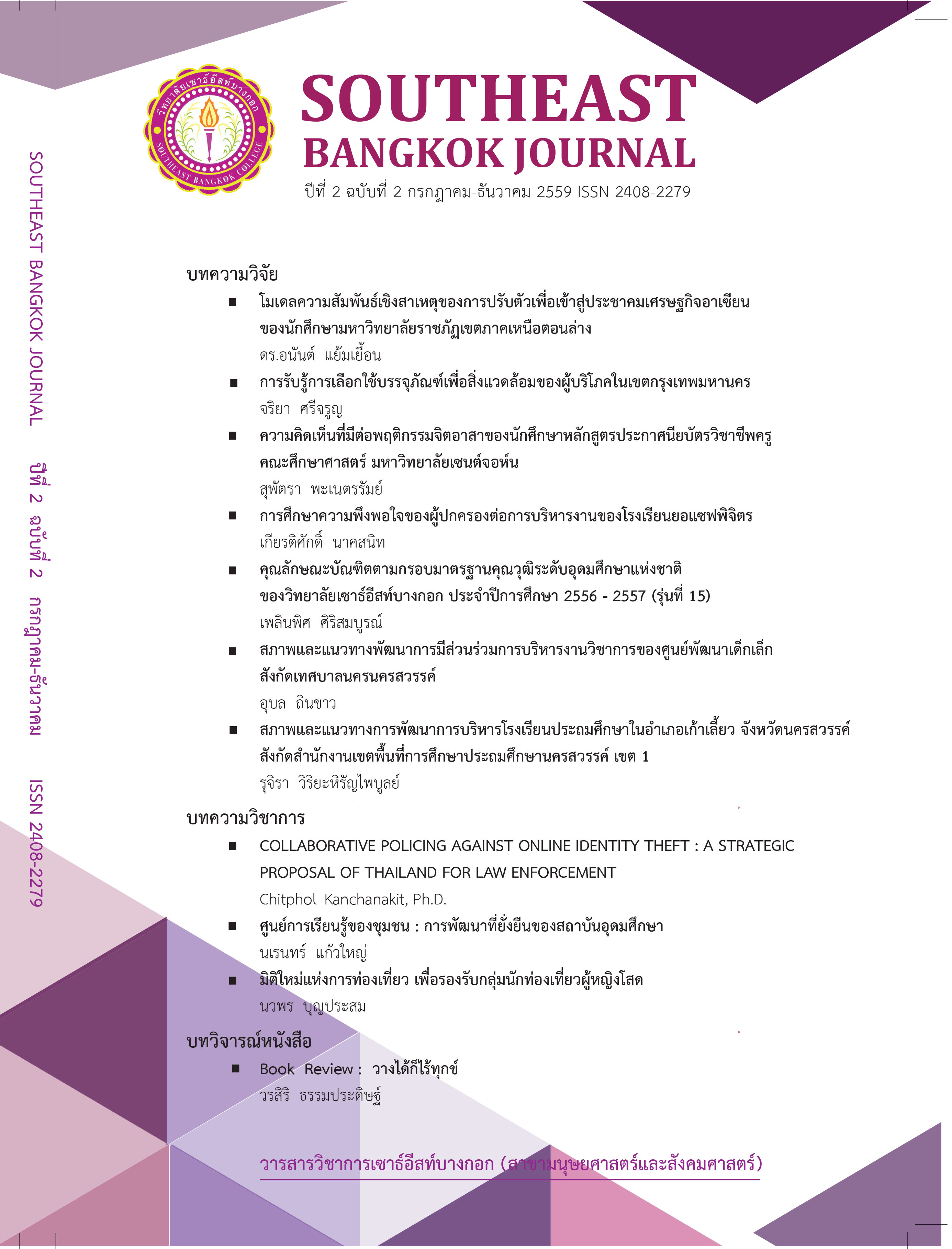COLLABORATIVE POLICING AGAINST ONLINE IDENTITY THEFT : A STRATEGIC PROPOSAL OF THAILAND FOR LAW ENFORCEMENT
Main Article Content
บทคัดย่อ
อ้างถึงข้อมติในการจัดการปัญหาอาชญากรรมคอมพิวเตอร์ซึ่งได้ยอมรับในที่ประชุมหัวหน้าตำรวจอาเซียนครั้งที่ 29 เมื่อปี 2009 บทความนี้มีวัตถุประสงค์เพื่อนำเสนอกิจการตำรวจแบบร่วมมือเพื่อต่อต้านการโจรกรรมข้อมูลส่วนบุคคลทางคอมพิวเตอร์โดยใช้การวิเคราะห์ความเป็นหุ้นส่วนบทความนี้แบ่งออกเป็น 5 ส่วน เริ่มต้นจากการพรรณนาถึงลักษณะของการโจรกรรมข้อมูลส่วนบุคคลทางคอมพิวเตอร์และสถานการณ์ในประเทศไทย ส่วนที่สองได้อธิบายถึงแนวคิดการเป็นหุ้นส่วนในการป้องกันอาชญากรรม ส่วนที่สามมุ่งเน้นไปที่หุ้นส่วนในด้านการตรวจตราทางคอมพิวเตอร์เพื่อต่อต้านอาชญากรรมการโจรกรรมข้อมูลส่วนบุคคล ส่วนที่สี่เป็นการประเมินการดำเนินการของประเทศไทยต่อการโจรกรรมข้อมูลส่วนบุคคลทางคอมพิวเตอร์ และส่วนสุดท้ายได้ให้ข้อเสนอแนะในการคุ้มครองข้อมูลส่วนบุคคลบนคอมพิวเตอร์จากการถูกโจรกรรมโดยมิจฉาชีพเนื่องจากหน่วยงานบังคับใช้กฎหมายในประเทศอาเซียนไม่ได้แสดงบทบาทอย่างเพียงพอในการต่อสู้กับการโจรกรรมข้อมูลส่วนบุคคลอันเนื่องจากความแตกต่างทางกฎหมายและนโยบายของแต่ละประเทศ และเครือข่ายทางสังคมทางคอมพิวเตอร์จำนวนมหาศาลของทั้งโลก รัฐอาเซียนจึงควรนำแนวคิดหุ้นส่วนเชิงยุทธศาสตร์ไปใช้ในทางปฏิบัติโดยแสวงหาความร่วมมือกับหุ้นส่วนภาคเอกชนและภาคประชาชนที่เกี่ยวข้อง
Article Details
เอกสารอ้างอิง
Gerard, G. J., Hillison, W., & Pacini, C. (2004). Identity theft : The US legal environmentand organisations related responsibilities. Journal of Financial Crime, (12), 33-43.
Jewkes, Y. (2010). Public policing and internet crime. In Jewkes, Yvonne & Yar, Majid (Eds),Handbook of internet crime. Devon: Willan Publishing.
Lessig, L. (1999). Code and other law of cyberspace. New York: Basic Books.
Rosenbaum, D. (2002). Evaluating multi-agency anti-crime partnerships: Theory,design, and measurement issues. Crime Prevention Studies, (14), 171-225.
Solove, Daniel J. (2003). Identity theft, privacy, and the architecture of vulnerability.Hastings Law Journal, (54), 1227-1235.
Steinert, Heinz. (1978). On the function of criminal law. Contemporaries Crises,(2), 167-193. Retrieved September 29, 2013, from
http://www.springerlink.com/content/u8221758u26x200g/
Udo, G. J. (2001). Privacy and security concerns as a major barriers for e-commerce:A survey study. Information Management and Computer Security, 9(4),Retrieved October 1, 2013, from http://www.emerald-library.com/ft
Wall, D. (2002). Insecurity and the policing of cyberspace. New York:Routledge.
Wall, D. (2007). Cybercrime: The transformation of crime in the Information age.Cambridge: Polity Press.
Wall, D. (2009-2010). Policing online behavior: How is cyberspace policed and by whom?, Cybercrime: Computer and crime in the information age.
Retrieved September 26, 2013, from http://webprod3.leeds.ac.uk/banner/dynmodules.asp?Y=201314&M=LAW-
5336M
Warden, F. V. (1992). Dimensions and types of policy networks. European Journal of Political Research, (21), 29-52.
Wright, R. (2002). Technology, and its effects on criminal responsibility, security and criminal justice, International society for the reform of criminal law, 16th international conference. Retrieved October 5, 2013, from www.isrol,org/Papers/Wrihgt.pdfs.


